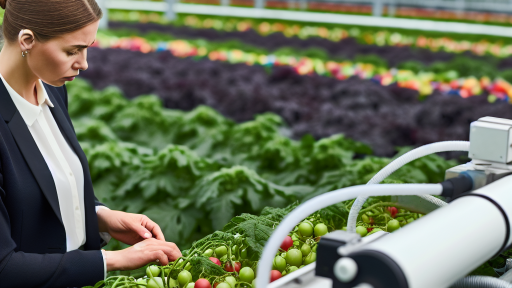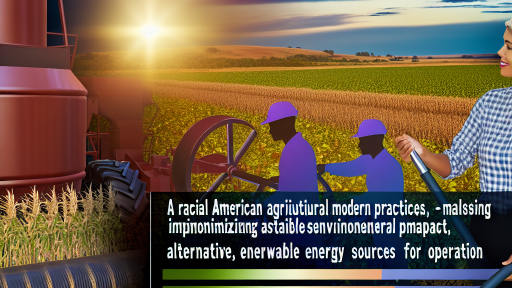Understanding Soil Erosion: Causes and Consequences in Organic Farming
Defining Soil Erosion
Soil erosion refers to the removal of the topsoil layer.
This process can lead to significant land degradation.
It negatively impacts fertility and agricultural productivity.
Causes of Soil Erosion in Organic Farming
Natural factors contribute to soil erosion in organic systems.
Intense rainfall can wash away valuable topsoil.
Wind can also displace soil particles, especially in dry areas.
Additionally, human activities exacerbate this issue.
For instance, poor management practices can increase vulnerability.
Overgrazing by livestock leads to vegetation loss.
Without plant cover, soil becomes more prone to erosion.
Consequences of Soil Erosion
Soil erosion has numerous adverse effects.
It decreases soil fertility, which hampers crop production.
Consequently, farmers may face reduced yields.
In turn, this can lead to financial hardships for producers.
Moreover, eroded soil can pollute nearby water sources.
Transform Your Agribusiness
Unlock your farm's potential with expert advice tailored to your needs. Get actionable steps that drive real results.
Get StartedThis occurs as sediments and chemicals are washed away.
Ultimately, soil erosion threatens sustainable farming practices.
Impact on Biodiversity
Soil erosion can disrupt local ecosystems.
It eliminates habitats for various organisms.
Decreased biodiversity weakens ecosystem resilience.
This makes agricultural systems less adaptable to changes.
Addressing Soil Erosion in Organic Farming
Farmers must adopt practices to mitigate soil erosion.
For instance, cover cropping helps protect the soil surface.
Crop rotation can enhance soil structure and health.
Furthermore, implementing contour farming can reduce runoff.
Education and awareness can empower producers to take action.
Overall, proactive measures are essential for maintaining soil health.
The Role of Cover Crops in Preventing Soil Erosion
Understanding Cover Crops
Cover crops are essential in organic farming systems.
These crops grow during the off-season of main crops.
They help protect the soil from erosion caused by wind and water.
Benefits of Cover Crops
Cover crops provide various benefits for soil health.
Firstly, they hold the soil in place with their root systems.
This rooting action helps to prevent soil loss.
Furthermore, cover crops enhance soil structure over time.
This improvement leads to better water infiltration.
Types of Effective Cover Crops
Different types of cover crops suit various farming conditions.
Legumes, such as clover and vetch, fix nitrogen in the soil.
This process boosts soil fertility naturally.
Meanwhile, grasses like rye and barley prevent erosion effectively.
Showcase Your Farming Business
Publish your professional farming services profile on our blog for a one-time fee of $200 and reach a dedicated audience of farmers and agribusiness owners.
Publish Your ProfileImplementing Cover Cropping Strategies
Farmers can adopt several strategies for cover cropping.
Clearly planning crop rotations helps maximize benefits.
Additionally, planting cover crops early in the season is crucial.
This timing promotes establishment before adverse weather occurs.
Monitoring and Maintenance
Regular monitoring of cover crops ensures their effectiveness.
Farmers should assess the growth and condition of these plants.
This assessment can guide the timing of termination.
Proper management promotes nutrient retention and prevents weeds.
Implementing Conservation Tillage Practices for Erosion Control
Understanding Conservation Tillage
Conservation tillage is a farming practice that reduces soil disturbance.
This method leaves previous crop residue on the field’s surface.
It minimizes soil erosion and enhances moisture retention.
Farmers need to adapt this approach to their specific soil types.
Types of Conservation Tillage
Different conservation tillage methods exist for effective soil management.
- No-till farming eliminates all soil disturbance.
- Reduced tillage involves minimal disturbance of the soil.
- Mulch-till practices leave a significant amount of residue.
Each method offers unique benefits for soil health.
Benefits of Conservation Tillage
Adopting conservation tillage improves soil structure and quality.
This technique enhances water infiltration, reducing runoff.
It promotes biodiversity by providing habitats for soil organisms.
Furthermore, conservation tillage can lower input costs for farmers.
Challenges in Implementing Conservation Tillage
Farmers may face challenges when transitioning to conservation tillage.
Initial soil compaction or weed pressure may increase before benefits appear.
Additionally, farmers must be educated about the methods and practices.
Financial constraints can also hinder the adoption of these techniques.
Strategies for Successful Implementation
A gradual transition can help farmers adopt conservation tillage effectively.
Collaborating with field experts can provide valuable insights.
Farmers should also participate in workshops and seminars for training.
Finally, joining a community of sustainable farmers encourages sharing best practices.
See Related Content: Choosing the Best Mulch Materials for Your Farm
Utilizing Crop Rotation Methods to Enhance Soil Stability
Understanding Crop Rotation
Crop rotation involves alternating the crops grown in a specific area over time.
This practice promotes soil health and reduces erosion.
Additionally, it disrupts pest and disease cycles.
Farmers can enhance the efficiency of their land using diverse crop species.
Benefits of Crop Rotation for Soil Stability
Crop rotation significantly improves soil structure.
It helps maintain soil moisture levels effectively.
Moreover, different root systems strengthen the soil foundation.
Rotating deep-rooted and shallow-rooted plants enhances nutrient uptake.
This leads to reduced soil compaction and erosion risk.
Implementing Effective Crop Rotation Plans
Farmers should design a rotation schedule based on local climate and soil types.
Including legumes can naturally enrich the soil with nitrogen.
Additionally, incorporating cover crops can prevent runoff during fallow periods.
Planning should also consider market demand for various crops.
Showcase Your Farming Business
Publish your professional farming services profile on our blog for a one-time fee of $200 and reach a dedicated audience of farmers and agribusiness owners.
Publish Your ProfileExamples of Crop Rotation Practices
For instance, alternating corn and soybeans is a common strategy.
This combination improves both crop yield and soil health.
Another method involves rotating brassicas with grains.
This strategy disrupts pests while enhancing biodiversity.
Challenges to Implementing Crop Rotation
Some farmers may face barriers in changing their traditional practices.
Time and knowledge gaps can hinder effective rotation planning.
Furthermore, market fluctuations can impact crop choices.
Support from agricultural extension services can aid farmers in overcoming these challenges.
Delve into the Subject: Mulching Strategies for Superior Weed Control
Integrating Agroforestry Techniques in Organic Farming Systems
The Role of Agroforestry in Soil Conservation
Agroforestry combines agriculture and forestry practices.
This technique enhances soil stability through root systems.
Additionally, it helps reduce water runoff and erosion.
As a result, farmers can maintain healthier soil conditions.
Diversity of Planting
Diverse crops and trees improve soil health significantly.
Mixing species creates a more resilient ecosystem.
Moreover, it offers habitats for beneficial insects.
This biodiversity improves pollination and pest management.
Implementing Buffer Strips
Buffer strips are crucial for protecting waterways.
They can consist of grasses or shrubs along field edges.
These strips trap sediments and filter nutrients effectively.
Consequently, they prevent pollutants from entering water bodies.
Practicing Contour Farming
Contour farming involves tilling across the slope of the land.
This method reduces soil erosion by following the landscape’s contours.
Additionally, it helps manage water runoff effectively.
Farmers can increase their crop yields through this technique.
Enhancing Agroforestry Planning
Successful agroforestry requires careful planning.
Farmers should consider climate, soil type, and local species.
Furthermore, they need to assess potential market needs.
This ensures that agroforestry systems are both productive and sustainable.
Engaging in Community Education
Community engagement is vital for successful agroforestry practices.
Farmers can share their experiences with others in the area.
Workshops and training sessions can spread knowledge effectively.
Collaboration fosters innovation and encourages sustainable practices.
Discover More: Effective Soil Testing Methods for Farmers

Mechanical Methods: Terracing and Contour Farming to Combat Erosion
Importance of Mechanical Erosion Control
Mechanical methods effectively reduce soil erosion in farming systems.
These techniques enhance soil structure and promote water retention.
Farmers can maintain healthier crops through these practices.
Terracing as a Tool
Terracing involves creating level areas on sloped land.
This technique minimizes water runoff and reduces soil loss.
Farmers can build terraces using various materials.
Showcase Your Farming Business
Publish your professional farming services profile on our blog for a one-time fee of $200 and reach a dedicated audience of farmers and agribusiness owners.
Publish Your ProfileSoil conservation increases significantly when terraces are implemented.
Types of Terraces
- Bench terraces create wide, flat areas on steep hills.
- Broad-based terraces allow for better crop cultivation.
- V-shaped terraces maximize water drainage efficiency.
Building Effective Terraces
Begin building terraces by evaluating the land’s slope.
Use local soil and vegetation to enhance stabilization.
Regular maintenance of terraces ensures long-term effectiveness.
Contour Farming and Its Benefits
Contour farming follows the natural contours of the land.
This method reduces soil erosion caused by water runoff.
Farmers can plant crops along the contour lines.
Thus, they capture water and nutrients effectively.
Techniques in Contour Farming
- Strip cropping alternates between row and cover crops.
- Agroforestry incorporates trees into farming systems.
- Cover crops protect soil during off-seasons.
Implementing Contour Farming
Farmers should assess their land’s topography for contour farming.
Proper planning significantly enhances crop yield.
Additionally, contour farming can prevent nutrient loss.
Discover More: Integrated Pest Management in Aquaponics
The Impact of Organic Mulching on Soil Protection
Understanding Organic Mulching
Organic mulching refers to the practice of covering soil with natural materials.
This can include straw, wood chips, or grass clippings.
These materials decompose over time, enriching the soil.
Furthermore, they help retain moisture in the soil.
Preventing Soil Erosion
Mulching effectively prevents soil erosion during heavy rainfall.
The layer of organic material acts as a barrier against raindrops.
Additionally, it reduces water runoff, allowing better absorption.
This process helps keep soil in place, reducing loss.
Enhancing Soil Fertility
Organic materials break down and add nutrients to the soil.
As they decompose, they create a rich habitat for beneficial microorganisms.
These microbes play a crucial role in nutrient cycling.
Moreover, they help improve soil structure, increasing its health.
Promoting Biodiversity
Improved soil health encourages plant diversity in farming systems.
Mulched areas attract various beneficial insects and organisms.
This not only aids in pest control but also boosts pollination.
Consequently, farmers achieve better yield and sustainable practices.
Implementing Effective Mulching Techniques
Choosing the right materials is important for effective mulching.
Different plants decompose at different rates, influencing nutrient supply.
A common choice is straw, as it breaks down relatively quickly.
Wood chips last longer but release nutrients more slowly.
It is vital to apply mulch at the appropriate thickness for maximum benefits.
Educating Farmers: Best Practices for Erosion Prevention in Organic Agriculture
Understanding Soil Erosion
SoiI erosion involves the removal of topsoil by various forces.
These forces include water, wind, and human activity.
Inorganic farming can exacerbate this issue through intensive practices.
Organic farmers must understand the risks associated with soil erosion.
By grasping these concepts, farmers can seek effective solutions.
Importance of Soil Conservation
Soil conservation plays a vital role in sustainable agriculture.
Healthy soil supports plant growth and enhances biodiversity.
Showcase Your Farming Business
Publish your professional farming services profile on our blog for a one-time fee of $200 and reach a dedicated audience of farmers and agribusiness owners.
Publish Your ProfileAdditionally, it aids in water retention and prevents runoff.
Consequently, conserved soil contributes to better crop yields.
This practice minimizes the need for chemical fertilizers and pesticides.
Implementing Best Practices
Farmers should adopt several best practices to prevent soil erosion.
These practices include crop rotation, cover cropping, and reduced tillage.
Crop Rotation
Crop rotation involves alternating different crops in the same field.
This practice disrupts pest cycles and enhances soil nutrient availability.
Furthermore, it helps maintain soil structure over time.
Cover Cropping
Cover crops provide ground cover during the off-season.
This protects the soil from wind and water erosion.
Cover crops also improve soil health by adding organic matter.
Moreover, they enhance biodiversity and help suppress weeds.
Reduced Tillage
Reduced tillage minimizes soil disturbance during farming operations.
This approach promotes soil structure and prevents erosion.
Lowering tillage intensity also helps maintain soil moisture levels.
Utilizing Erosion Control Techniques
Employing different erosion control techniques is crucial in organic farming.
These techniques can combat soil erosion effectively.
Terracing
Terracing involves creating stepped levels on sloped land.
This method slows water runoff and captures topsoil.
Terraces also provide flat areas for crop production.
Using Vegetative Buffer Strips
Vegetative buffer strips consist of grasses and shrubs planted along waterways.
These strips filter runoff and reduce sediment flow into water bodies.
They also enhance local wildlife habitats and encourage biodiversity.
Building Compost and Mulch Layers
Adding layers of compost and mulch protects the soil surface.
These layers hold moisture and reduce the impact of raindrops on the soil.
Furthermore, they provide nutrients as they decompose over time.
Engaging in Community Education
Farmers benefit significantly from community education initiatives.
Workshops and seminars can inform farmers about erosion prevention techniques.
Collaboration among farmers fosters knowledge sharing and innovation.
Furthermore, local governments can support educational programs.
These programs emphasize the significance of sustainable practices.




